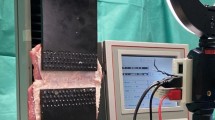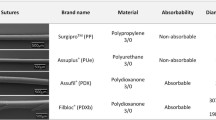Abstract
Introduction
Achieving adequate surgical exposure is fundamental to good surgical practice. Traditionally, in the repair of ventral and open inguinal hernias, this has been accomplished with the aid of self-retaining retractors or by extending the incision length. We propose that using disposable wound protectors, surgical exposure will be improved for a given incision length in the repair of ventral and open inguinal hernias, compared to traditional methods.
Method
Through the use of an animal tissue model, we compared incisions of varying lengths and measured the dimensions of the exposure achieved with disposable wound protectors (Alexis™) and a Mollison self-retainer. We calculated the surface area and, therefore, exposure gained using the specified wound retraction devices and compared the results.
Results
The average superficial surface area of wound with a self-retainer compared to the small and extra-small disposable wound protector was 2.65 cm2 vs 2.27 cm2 (small) and 2.2 cm2 (extra-small) for 2 cm incision length, 3.6 cm2 vs 4.93 cm2 and 4.2 cm2 for 3 cm incision length, 5.19 cm2 vs 8.25 cm2 and 6.27 cm2 for 4 cm incision length, 6.17 cm2 vs 12.25 cm2 and 9.07 cm2 for 5 cm incision length, and 8.75 cm2 vs 16.73 cm2 and 10.78 cm2 for 6 cm incision length [p = 0.038 (small) and p = 0.049 (extra-small)]. Our results show a statistically significant increase in surface area of a wound for each incision length when a disposable wound protector was used for exposure, compared to a self-retainer.
Conclusion
Our results demonstrate that the use of disposable wound protectors provides superior surgical exposure for a given incision length compared to traditional techniques in the repair of ventral and open inguinal hernia repairs.
Similar content being viewed by others
References
Arenal J, Martinez A, Maderuelo MV et al (2016) Reduced wound infection in colorectal resection by using a wound auto-retractor. Le Infezioni in Medicinia 4:310–317
Bueno-Lledo J, Torregrosa-Gallud A, Sala-Hernandez A et al (2017) Predictors of mesh infection and explanation after abdominal wall hernia repair. Am J Surg 213:50–57
Cheng KP, Roslani AC, Sehha N et al (2012) ALEXIS O-Ring wound retractor vs conventional wound protection for the prevention of surgical site infections in colorectal resections. Colorectal Dis 14:346–351
Dessy LA, Fallico N, Serratore F et al (2016) The use of the alexis device in breast augmentation to improve outcomes: a comparative randomized case–control survey. Gland Surg 5(3):287–294
Gheorge A, Calvert M, Pinkney TD et al (2012) Systematic review of the clinical effectiveness of wound-edge protection devices in reducing surgical site infection in patients undergoing open abdominal surgery. Ann Surg 255(6):1017–1029
Hinkson L, Siedentopf JP, Weichert A et al (2016) Surgical site infection in caesarean sections with the use of a plastic sheath wound retractor compared to the traditional self-retaining metal retractor. Eur J Obstet Gynecol Reprod Biol 203:232–238
Horiuchi T, Tanishima H, Tamagawa K et al (2007) Randomised, controlled investigation of the anti-infective properties of the alexis retractor/protector of incision sites. J Trauma 62:212–215
Mariona FG, Plymel KL (2015) Use of the “O” wound protector/retractor in extremely obese pregnant woman—an unexpected event. J Women’s Health Care. https://doi.org/10.4172/2167-0420.1000248
McIntyre MK, Peacock TJ, Akers KS, Burmeister DM (2016) Initial characterization of the pig skin bacteriome and its effect on in vitro models of wound healing. PLOS One. https://doi.org/10.1371/journal.pone.0166176
Reid K, Pockney P, Draganic B, Smith S (2010) Barrier wound protection decreases surgical site infection in open elective colorectal surgery: a randomized clinical trial. Dis Colon Rectum 53:1374–1380
Sajid MS, Rathore MA, Sains P et al (2017) A systematic review of the clinical effectiveness of wound edge protector devices in reducing surgical site infections in patients undergoing abdominal surgery. Updates Surg 69(1):21–28
Terzi C (2006) Antimicrobial prophylaxis in clean surgery with special focus on inguinal hernia repair with mesh. J Hosp Infect 62:427–436
Zhang MX, Sun YH, Zheng X et al (2015) Wound edge protector for prevention of surgical site infection in laparotomy: an updated systematic review and meta-analysis. ANZ J Surg 85:308–314
Author information
Authors and Affiliations
Corresponding author
Ethics declarations
Conflict of interest
The authors have no conflicts of interest to declare.
Ethical approval
The Animal Care and Ethics Committee (ACEC) acknowledged this research and advised that the ACEC was satisfied that animals on this project will be used in an ethical manner.
Human and animal rights
This article does not contain any studies with animals performed by any of the authors.
Informed consent
None.
Additional information
Publisher's Note
Springer Nature remains neutral with regard to jurisdictional claims in published maps and institutional affiliations.
Electronic supplementary material
Below is the link to the electronic supplementary material.
Rights and permissions
About this article
Cite this article
Lawson, J., McGill, A., Meares, H. et al. Wound protectors for improved exposure in open hernia repair. Hernia 23, 1215–1219 (2019). https://doi.org/10.1007/s10029-019-01952-6
Received:
Accepted:
Published:
Issue Date:
DOI: https://doi.org/10.1007/s10029-019-01952-6




